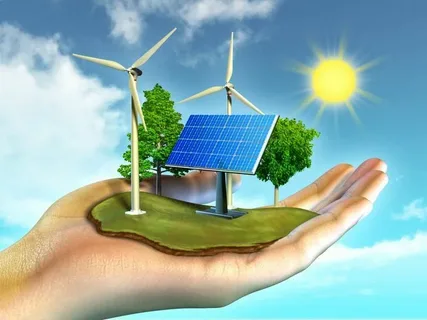In the modern era, the quest for cleaner, more sustainable energy has taken center stage. As the world confronts the challenges of climate change and environmental degradation, renewable energy sources have emerged as a vital solution. These sources of energy are not only environmentally friendly but also offer long-term economic benefits. In this post, we’ll explore the different types of renewable energy sources and their importance in the global energy mix, with a particular focus on the role that companies like Shakarzahi LLC play in advancing renewable energy solutions.
What Are Renewable Energy Sources?
Renewable energy refers to energy derived from natural resources that are continuously replenished on a human timescale. These resources include sunlight, wind, rain, tides, waves, and geothermal heat. Unlike fossil fuels such as coal, oil, and natural gas, which are finite and contribute significantly to environmental pollution, renewable energy is clean and virtually inexhaustible.
The main types of renewable energy sources include:
- Solar Energy
Solar energy is derived from the sun’s radiation and can be converted into electricity or heat. Photovoltaic (PV) systems, solar panels, and solar thermal collectors are common methods for capturing and utilizing solar power. As technology advances, the efficiency of solar panels continues to improve, making solar energy one of the fastest-growing renewable energy sectors. It is widely used in residential, commercial, and industrial applications. - Wind Energy
Wind energy harnesses the power of wind to generate electricity. Wind turbines, placed in wind farms or offshore, capture the kinetic energy of wind and convert it into electrical energy. Wind energy has become a significant player in the renewable energy industry, particularly in countries with vast open spaces and consistent wind patterns. The scalability of wind energy makes it a crucial component of large-scale energy strategies. - Hydropower
Hydropower, or hydroelectric energy, generates electricity from the flow of water. It’s one of the oldest and most established forms of renewable energy, providing power by capturing the kinetic energy of rivers or man-made dams. Hydropower is a reliable and steady source of energy, although its development can be limited by geographical factors and environmental concerns. - Geothermal Energy
Geothermal energy taps into the Earth’s internal heat to produce electricity or provide direct heating. Geothermal plants utilize the heat from underground reservoirs of hot water or steam to power turbines. This energy source is consistent and reliable, making it an excellent option for baseload electricity generation in areas with significant geothermal activity. - Biomass Energy
Biomass energy is derived from organic materials such as plant waste, agricultural residues, and wood. It can be used for heating, electricity generation, or as biofuel for transportation. Although biomass is a renewable source, it requires careful management to ensure sustainability, as burning biomass can release carbon dioxide. However, with proper techniques, biomass can offer a carbon-neutral alternative to fossil fuels.
The Benefits of Renewable Energy
The transition to renewable energy sources offers numerous benefits:
- Environmental Protection
The most significant advantage of renewable energy is its positive impact on the environment. Unlike fossil fuels, which release harmful greenhouse gases and pollutants into the atmosphere, renewable energy sources produce little to no emissions. This helps mitigate climate change, reduce air and water pollution, and preserve ecosystems. - Energy Security
Renewable energy reduces reliance on finite fossil fuels, which are often subject to geopolitical tensions and market volatility. By diversifying the energy mix with renewable sources, countries can achieve greater energy security and reduce their dependence on foreign oil and gas. - Economic Growth
The renewable energy sector has become a significant driver of economic growth. Investments in renewable technologies create jobs, stimulate innovation, and promote local economies. In regions where traditional energy industries are in decline, renewable energy offers new opportunities for workforce development and economic revitalization. - Sustainability
Renewable energy sources are sustainable by nature, as they are replenished continuously. This ensures a stable energy supply for future generations. Additionally, renewable energy technologies have a smaller ecological footprint, preserving natural resources for other essential uses.
The Role of Shakarzahi LLC in Advancing Renewable Energy
At the forefront of renewable energy innovation is Shakarzahi LLC, a company committed to providing cutting-edge solutions that address the growing demand for clean energy. With a focus on energy storage systems, Shakarzahi LLC plays a pivotal role in ensuring the efficient and reliable distribution of renewable energy sources.
Energy storage systems are essential for managing the intermittent nature of some renewable sources, such as solar and wind power. By capturing excess energy when production is high and releasing it when demand spikes or production dips, these systems enhance grid stability and ensure a constant supply of electricity.
Shakarzahi LLC has invested in developing state-of-the-art battery storage systems that complement renewable energy infrastructure. Their innovative approach includes integrating renewable energy sources with advanced storage technologies, making renewable energy a more practical and accessible option for homes, businesses, and entire communities.
In addition to energy storage, Shakarzahi LLC actively supports the development of solar, wind, and geothermal projects. By providing technical expertise, financing options, and end-to-end support, they help accelerate the adoption of renewable energy in both established and emerging markets.
The Future of Renewable Energy
As the world continues to embrace renewable energy sources, the future looks promising. With technological advancements, declining costs, and growing public awareness, renewable energy is poised to become the dominant source of power in the coming decades. Companies like Shakarzahi LLC are driving this transformation by delivering innovative solutions that make renewable energy more efficient, reliable, and accessible to all.
Conclusion
Renewable energy sources are not just a trend; they are the foundation of a sustainable future. The benefits of transitioning to renewable energy—environmental protection, energy security, economic growth, and sustainability—are too significant to ignore. As a key player in this global movement, Shakarzahi LLC continues to lead the way in promoting clean energy solutions and building a greener, more sustainable world for future generations.







